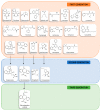Fighting Epilepsy with Nanomedicines-Is This the Right Weapon?
- PMID: 36839629
- PMCID: PMC9959131
- DOI: 10.3390/pharmaceutics15020306
Fighting Epilepsy with Nanomedicines-Is This the Right Weapon?
Abstract
Epilepsy is a chronic and complex condition and is one of the most common neurological diseases, affecting about 50 million people worldwide. Pharmacological therapy has been, and is likely to remain, the main treatment approach for this disease. Although a large number of new antiseizure drugs (ASDs) has been introduced into the market in the last few years, many patients suffer from uncontrolled seizures, demanding the development of more effective therapies. Nanomedicines have emerged as a promising approach to deliver drugs to the brain, potentiating their therapeutic index. Moreover, nanomedicine has applied the knowledge of nanoscience, not only in disease treatment but also in prevention and diagnosis. In the current review, the general features and therapeutic management of epilepsy will be addressed, as well as the main barriers to overcome to obtain better antiseizure therapies. Furthermore, the role of nanomedicines as a valuable tool to selectively deliver drugs will be discussed, considering the ability of nanocarriers to deal with the less favourable physical-chemical properties of some ASDs, enhance their brain penetration, reduce the adverse effects, and circumvent the concerning drug resistance.
Keywords: antiseizure drugs; epilepsy; lipid-based nanosystems; nanomedicines; nanotechnology; polymeric nanoparticles.
Conflict of interest statement
The authors declare no conflict of interest.
Figures


Similar articles
-
Biodegradable nanoparticles for the treatment of epilepsy: From current advances to future challenges.Epilepsia Open. 2022 Aug;7 Suppl 1(Suppl 1):S121-S132. doi: 10.1002/epi4.12567. Epub 2021 Dec 13. Epilepsia Open. 2022. PMID: 34862851 Free PMC article. Review.
-
Nanomedicine revolutionizes epilepsy treatment: overcoming therapeutic hurdles with nanoscale solutions.Expert Opin Drug Deliv. 2024 May;21(5):735-750. doi: 10.1080/17425247.2024.2360528. Epub 2024 May 26. Expert Opin Drug Deliv. 2024. PMID: 38787859 Review.
-
Trends in Nanomedicines for Cancer Treatment.Curr Pharm Des. 2020;26(29):3579-3600. doi: 10.2174/1381612826666200318145349. Curr Pharm Des. 2020. PMID: 32186271
-
Validated animal models for antiseizure drug (ASD) discovery: Advantages and potential pitfalls in ASD screening.Neuropharmacology. 2020 May 1;167:107750. doi: 10.1016/j.neuropharm.2019.107750. Epub 2019 Aug 27. Neuropharmacology. 2020. PMID: 31469995 Free PMC article. Review.
-
A review of the current scientific and regulatory status of nanomedicines and the challenges ahead.PDA J Pharm Sci Technol. 2011 Mar-Apr;65(2):177-95. PDA J Pharm Sci Technol. 2011. PMID: 21502077 Review.
Cited by
-
Nanotherapeutics for Alleviating Anesthesia-Associated Complications.Adv Sci (Weinh). 2024 Apr;11(15):e2308241. doi: 10.1002/advs.202308241. Epub 2024 Feb 11. Adv Sci (Weinh). 2024. PMID: 38342603 Free PMC article. Review.
-
Ethosuximide-loaded bismuth ferrite nanoparticles as a potential drug delivery system for the treatment of epilepsy disease.PLoS One. 2024 Sep 23;19(9):e0305335. doi: 10.1371/journal.pone.0305335. eCollection 2024. PLoS One. 2024. PMID: 39312534 Free PMC article.
-
Crosslinked Chitosan Nanoparticles with Muco-Adhesive Potential for Intranasal Delivery Applications.Int J Mol Sci. 2023 Apr 1;24(7):6590. doi: 10.3390/ijms24076590. Int J Mol Sci. 2023. PMID: 37047562 Free PMC article.
-
Exploring the neuroprotective benefits of phytochemicals extracted from indigenous edible fruits in Bangladesh.Animal Model Exp Med. 2025 Feb;8(2):239-265. doi: 10.1002/ame2.12522. Epub 2025 Jan 14. Animal Model Exp Med. 2025. PMID: 39808386 Free PMC article. Review.
-
A Revolutionary Approach for Combating Efflux Transporter-mediated Resistant Epilepsy: Advanced Drug Delivery Systems.Curr Pharm Des. 2025;31(2):95-106. doi: 10.2174/0113816128332345240823111524. Curr Pharm Des. 2025. PMID: 39279709 Review.
References
-
- World Health Organization Epilepsy. 2022. [(accessed on 17 June 2022)]. Available online: https://www.who.int/news-room/fact-sheets/detail/epilepsy.
Publication types
Grants and funding
LinkOut - more resources
Full Text Sources

